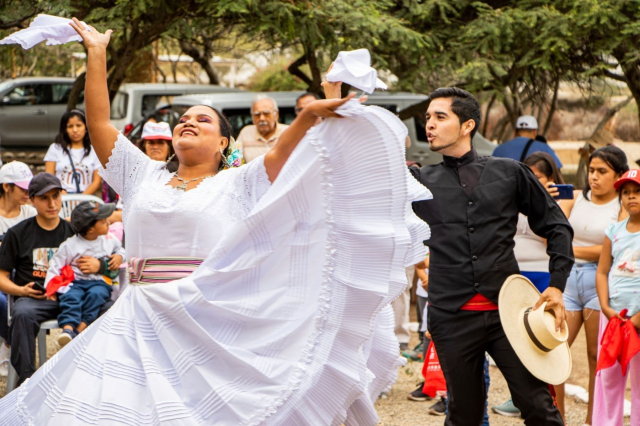Peru's traditional dances in July are an explosion of color, music, and tradition, celebrated with great fervor in plazas, schools, public institutions, and cultural centers throughout the country. During the Fiestas Patrias (National Holidays), Peru revives its deepest roots through choreographic performances that not only entertain but also educate and inspire. Each dance, from the subtle elegance of the Marinera to the intensity of the Festejo (Festival), reflects the country's history, cultural diversity, and its diverse heritage.
During this month, schools hold special activities where students, along with their teachers and families, prepare traditional dances representing the different regions of Peru: the coast, the mountains, and the jungle. Public squares also come alive with folklore competitions, parades, and cultural fairs. This article will help you learn about the most representative dances performed in July, their characteristics, symbolism, and the positive impact they have on the cultural development of citizens, especially children and young people.
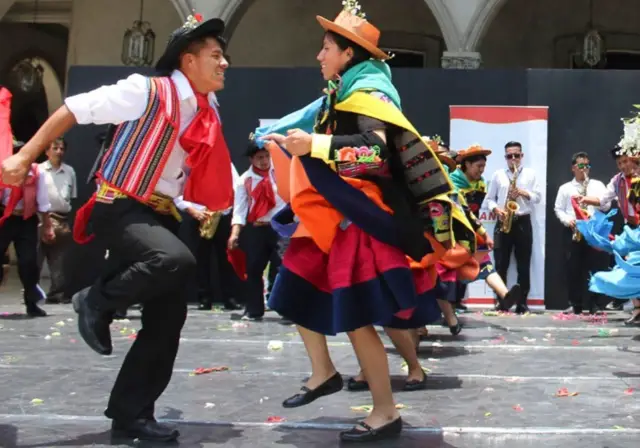
1. Marinera Norteña
Origin and meaning
The Marinera Norteña, considered Peru's national dance, has its roots in the northern coast, especially in regions such as La Libertad and Piura. This dance represents the game of conquest between a man and a woman, who communicate through body language, handkerchief movements, and elegant footwork. It is a mestizo dance, a blend of Hispanic, African, and indigenous influences, notable for its elegance, flirtatiousness, and technical difficulty.
Outfit
Gentleman : black pants, white shirt, straw hat, white handkerchief.
Ladies : loose embroidered cotton dress, traditional colours such as red, white or blue, matching headscarf and updo.
This attire not only highlights the aesthetics of the dance, but also the historical context of the 19th and 20th centuries on the Peruvian coast.
Presence in schools and squares
During July, the Marinera is one of the most performed dances in schools at all levels, from preschool to high school. School Marinera competitions not only foster discipline and teamwork but also reinforce national identity. In plazas and urban settings, it's common to witness festivals where this dance takes center stage, accompanied by live bands performing traditional songs.
2. Huayno
Andean origin
The Huayno is one of the oldest musical and dance expressions of the Peruvian Andes. It has pre-Incan roots and has evolved over the centuries, incorporating colonial and contemporary influences. This dance expresses both the joy and sadness of the Andean people and is commonly seen at religious festivals, agricultural celebrations, and community gatherings.
Characteristics
Instruments: quena, zampoña, guitar, charango and bass drum.
Clothing: Women wearing embroidered skirts and colorful blouses, men wearing ponchos and felt or straw hats.
Rhythm: fast-paced tapping, turns, and side steps marked to the beat of nostalgic melodies.
The Huayno varies according to the region, for example, the Huayno from Ayacucho is more relaxed and sentimental, while the Huayno from Cusco is cheerful and energetic.
In the school context
During July, students rehearse months in advance to present the Huayno at civic events. This practice seeks to keep Andean heritage alive, reinforce values such as respect for traditions, and enrich comprehensive education with elements of folklore. Cultural fairs are often organized where students also explain the meaning of their dance and costumes.
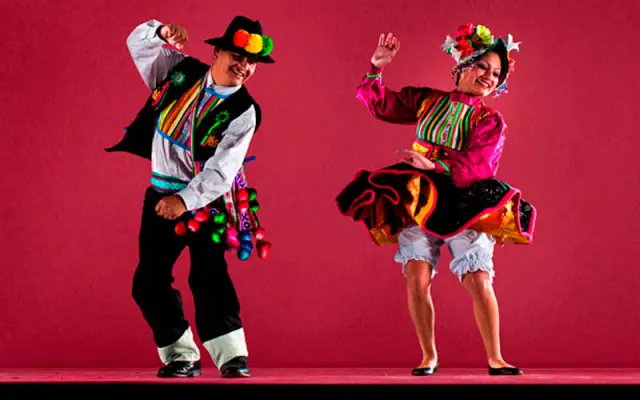
3. Celebration and Black Carnival
Afro-Peruvian heritage
The Black Festival and Carnival are emblematic dances of Afro-Peruvian culture, primarily found in the southern coastal regions of Chincha and Cañete. These artistic expressions are the result of centuries of cultural resistance, where African slaves preserved their identity through rhythm, song, and body movement.
Dance and costumes
Clothing: Women wear full skirts, sleeveless blouses, headscarves, or decorated braids; men wear open shirts, light-colored pants, and hats.
Rhythm: intense percussion with the cajón, the donkey jaw, clapping and Creole guitar.
Movement: free steps, rhythmic improvisations, interaction with the audience and great expressiveness.
Exhibitions in July
During July, the Black Festival and Carnival are included in celebrations that promote inclusion and recognition of Afro-descendant cultures. Schools integrate them into civic-cultural programs, fostering respect for Peru's ethnic diversity. There are also Afro-Peruvian festivals that honor the originality and authenticity of dances.
4. Sicuri or Sikuri
Tradition of the highlands
Sicuri is a collective dance originating from the Peruvian highlands, especially Puno. It is characterized by the participation of numerous musicians playing zampoñas (sikus) while dancing in synchronized rhythm. This dance has a spiritual connection to the earth and the apus (mountain spirits) and is often performed during patron saint festivals and carnivals.
Instruments and staging
Instruments: large sets of panpipes divided by pitch, accompanied by drums.
Clothing: Typical altiplano costumes with multi-colored ponchos, chullos, baize skirts, and sturdy boots.
Presentation: choreography in a circle or in a line, with movements to the rhythm of the Andean wind.
Educational and cultural value
By including Sicuri in school events in July, recognition of the Aymara and Quechua communities is promoted. It also values collective work and respect for oral and musical traditions passed down from generation to generation. In some schools, musicians from Puno are invited to lead workshops for students.
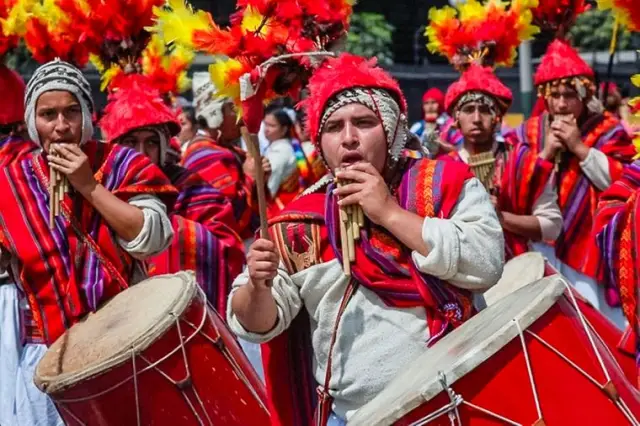
5. Scissors dance
Origin and symbolism
The Scissor Dance is one of the most complex and emblematic cultural expressions of Andean Peru. Originating in the regions of Ayacucho, Apurímac, and Huancavelica, this dance is not only a demonstration of physical skill but also of spirituality. The dancers, known as "scissor dancers," compete against each other in a kind of artistic duel that includes acrobatics, extreme spins, and challenging physical tests, all while they jingle a pair of metal scissors in their hands. This dance was declared an Intangible Cultural Heritage of Humanity by UNESCO.
Clothing and music
Clothing: hand-embroidered outfits with Andean motifs, sequined capes, reinforced boots, and a crown or montera.
Music: accompanied by a duo composed of a violinist and a harpist who follow the rhythm and respond to the dancer's challenges.
Elements: scissors, which mark the rhythm with a particular sound and are considered a sacred instrument.
Exhibition in July
Although its greatest presence is in religious celebrations such as those of the Virgin of Carmen or the Lord of Qoyllur Rit'i, the scissors dance has been included in many schools and municipal presentations in July due to its great symbolic value. Its presence in national activities provides a unique perspective on Andean spirituality and the cultural syncretism present in Peru.
6. Comparison in a table
| Dance | Region | Main instruments | Typical clothing |
|---|---|---|---|
| Northern Marinera | Coast | Guitar, cajón, repique | Elegant coastal suit, scarves |
| Huayno | Saw | Quena, zampoña, guitar | Ponchos, skirts, straw hats |
| Black Carnival/Celebration | Coast | Cajon, guitar, donkey jawbone | Colorful skirts, turbans, scarves |
| Security | Plateau | Zampoñas, drum | Ponchos, skirts, altiplano hats |
| Scissors dance | Central Andes | Violin, harp | Embroidered clothing, metal scissors, boots |
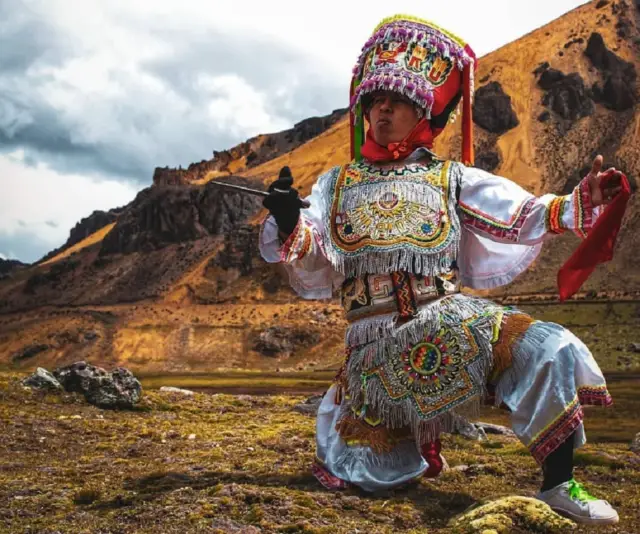
7. Benefits of promoting these dances in schools
The pedagogical value of incorporating traditional Peruvian dances into education is immense. First, it allows students to understand and appreciate the country's cultural diversity, fostering a strong national identity from an early age. Furthermore, preparing artistic performances develops skills such as body language, teamwork, and discipline. Traditional dances also offer an interdisciplinary approach, connecting areas such as history, music, physical education, and art.
On the other hand, including regional cultural expressions in the school curriculum also contributes to inclusion and respect for diversity , promoting the integration of students from different backgrounds. It also strengthens the self-esteem of those who see their customs represented in educational settings, turning the school into a meeting place, not only for academic knowledge but also for cultural knowledge.
A country that expresses itself through dancing
The traditional dances presented in July are not only a visual and musical delight, but also a powerful tool for building citizenship. Each choreography represents centuries of history, a blend of cultures, and a deep love for Peru. In schools, plazas, theaters, and streets, Peruvians dance not only out of tradition but also out of commitment to their identity. This practice strengthens the social fabric, fosters respect for diversity, and keeps our country's roots alive.
Celebrating the National Holidays with traditional dances is also a way to look to the future with our feet firmly planted in the past. Participating in these activities not only enriches the students, but also the entire communities that gather, collaborate, and celebrate together. Thus, July becomes a month where all of Peru dances to the rhythm of its history.
